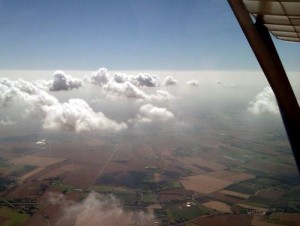Learning to fly is an enjoyable and fun experience. Once you have your pilot’s licence you can enjoy the amazing views in the ever changing skies, and share the experience of flight with your friends and family.
What is the NPPL?
 The National Private Pilots Licence (NPPL) is a licence for recreational pilots. It requires far less investment in time and money to obtain than a traditional PPL, making it the most popular choice for those pilots who have no wish to fly commercially, although pilots who start with an NPPL can and do progress to a PPL and even to a commercial licence: One pilot who learnt to with us now flies the route from Land’s end to the Isles of Scilly
The National Private Pilots Licence (NPPL) is a licence for recreational pilots. It requires far less investment in time and money to obtain than a traditional PPL, making it the most popular choice for those pilots who have no wish to fly commercially, although pilots who start with an NPPL can and do progress to a PPL and even to a commercial licence: One pilot who learnt to with us now flies the route from Land’s end to the Isles of Scilly
To qualify for a National Private Pilots Licence (NPPL) you’ll need to fly for a minimum of 25 hours in total, 10 hours of which will be solo flying, supervised by your instructor. On average, you should plan for 35-45 hours to complete your training, flying more regularly will generally mean you can complete the course in fewer hours.
The NPPL is valid in the UK, France and many other countries, so whether you fly locally or travel internationally, getting your licence will open up a whole new world.
The cost of achieving an NPPL on microlight aircraft isn’t as expensive as you might think, in fact it works out at roughly half of what it would cost you to gain a full PPL, and flying lightweight high performance modern microlights such as the C-42 is at least twice as much fun!
NPPL Ground School
In addition to the flying course there are ground 5 exams with multiple choice questions on the following subjects:
- Human Performance and Limitations
- Air Law
- Meteorology
- Navigation
- Aircraft Technical
Most students choose to self study for the exams, but we can provide ground school if required and we have a dedicated ground school classroom for this.
About the Flying Course:
 The first few lessons of your training will concentrate on the basics of flying the aircraft: The effects of each control, flying straight and level, and then climbing, descending, and turning the aircraft accurately. Once you are happy and confident with these we move on to more advanced handling, along with introducing what for many people is the most challenging and fun (if occasionally frustrating) part of flying: Learning to land.
The first few lessons of your training will concentrate on the basics of flying the aircraft: The effects of each control, flying straight and level, and then climbing, descending, and turning the aircraft accurately. Once you are happy and confident with these we move on to more advanced handling, along with introducing what for many people is the most challenging and fun (if occasionally frustrating) part of flying: Learning to land.
Once you can fly well and land the aircraft safely and consistently you will be sent on your first solo flight, a major landmark that you’ll remember for the rest of your life.
From then on you’ll alternate between building solo hours when the weather is at it’s most benign, and navigation and other more advanced duel training such as low level flying when conditions are more challenging. Then, after a session or two of revision, you’ll be ready to take your General Skills Test and become a fully fledged pilot.
Age and medical limitations:
It’s possible to start training at 14, however you will need to be 16 to go solo and 17 to hold a licence. The upper age limit is 74.
Weight limits: There is a max. weight limit of 115kg (approx. 18 stone.)
Medical requirements are simple: If you can drive a car you can fly a microlight. The only exception is if you are taking medication for a psychiatric illness, in which case you’ll need to seek the advice of a Aeronautical Medical Examiner, otherwise there is just a simple self-declaration form to fill in. The self-declaration is valid until you are 70, after that you’ll need to re-declare every 3 years.
Find out more: Our Prices.
